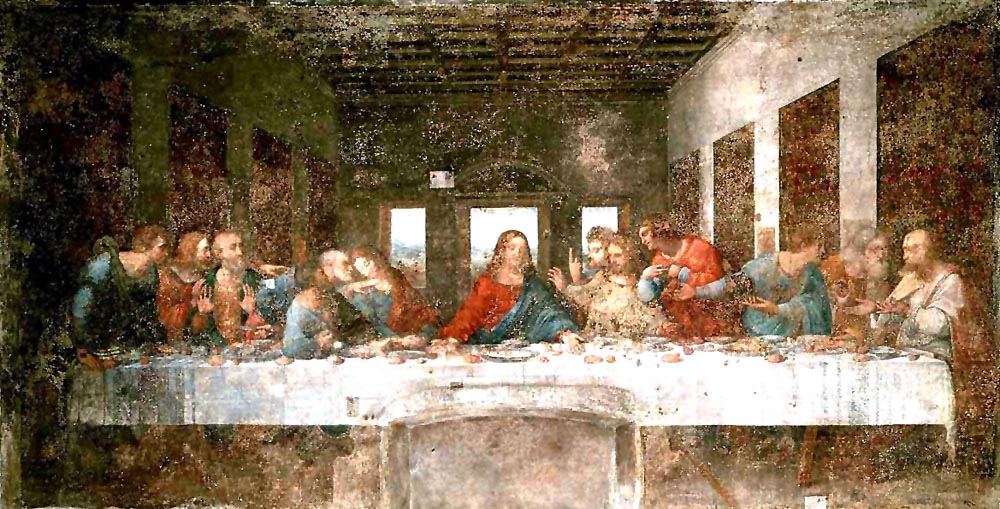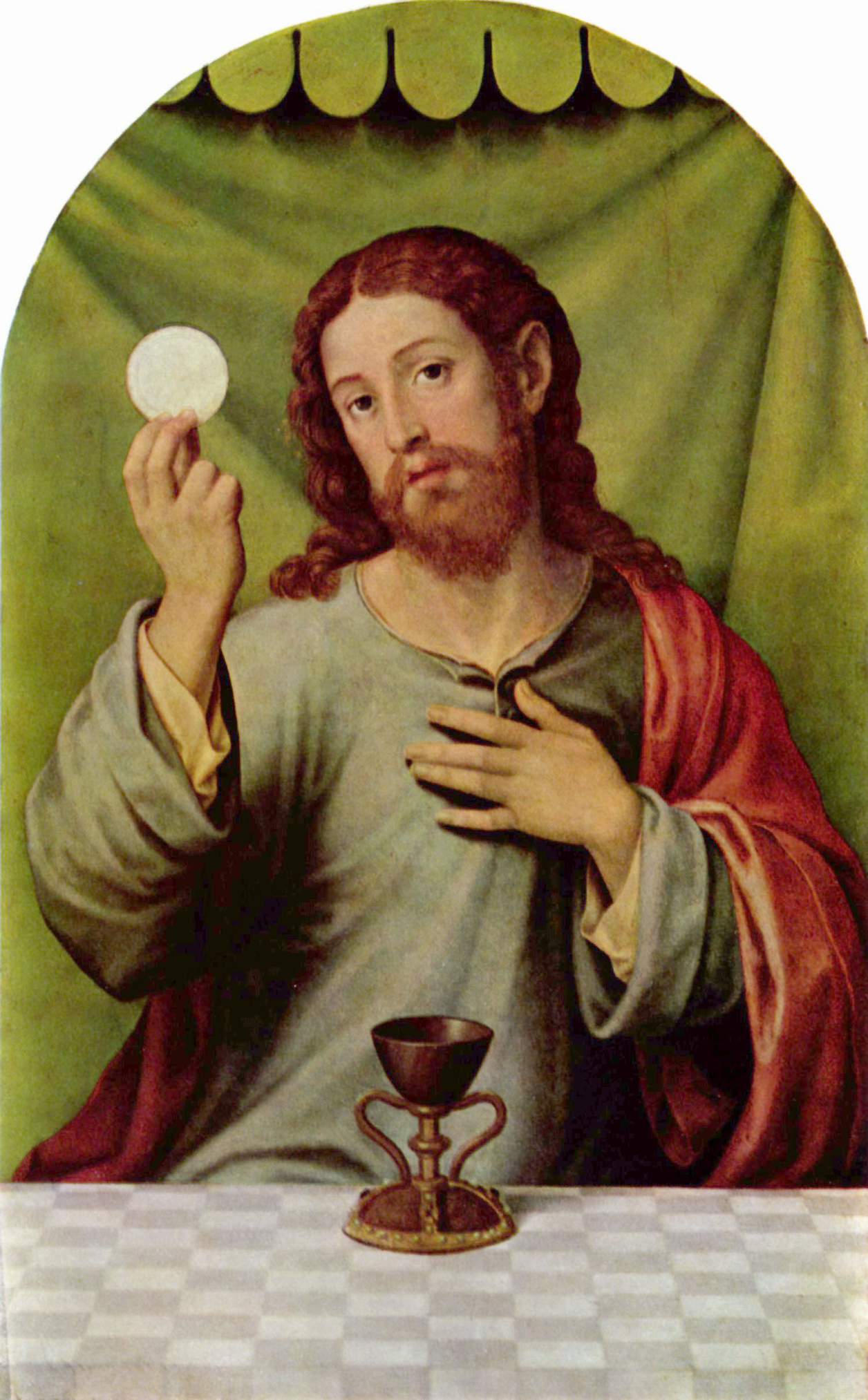|
The First Supper
''The First Supper'' (1988) is a work of art by Susan Dorothea White, based on Leonardo da Vinci's 1490s painting ''The Last Supper''. White's painting is acrylic on a large wood panel (1.2 x 2.4 m) and, in a challenge to the patriarchal concept of thirteen men on one side of a table, shows 13 women from all regions of the world; the woman in the position of Leonardo's Christ figure is an Australian aboriginal wearing a T-shirt with the Australian Aboriginal Flag. One woman seen is in the position of Judas. She dines on a Coca-Cola and a hamburger, while all the other women are seen with a bread roll and glass of water. The painting toured Australia in the Blake Prize for Religious Art exhibition in 1988, where it was ridiculed, before being exhibited in the artist's solo exhibition in Amsterdam, where it featured in the Dutch art journal ''Kunstbeeld'': "The work shows clearly Susan White's thinking about human rights. It should be mentioned here that she sometimes places her ... [...More Info...] [...Related Items...] OR: [Wikipedia] [Google] [Baidu] |
Susan Dorothea White
Susan Dorothea White (born 10 August 1941) is an Australian artist and author. She is a narrative artist and her work concerns the natural world and human situation, increasingly incorporating satire and irony to convey her concern for human rights and equality. She is the author of ''Draw Like da Vinci'' (2006). Education and early career Born in Adelaide, South Australia on 10 August 1941, White grew up in the outback mining town of Broken Hill. She started boarding school in Adelaide in 1954, returning home to Broken Hill during school vacations to paint and draw. White first exhibited in 1957; in 1958, while still at school, she began accepting commissions and attended Saturday drawing classes conducted by the artist James Cant in Adelaide. From 1959 to mid-1960, White was a student in the Diploma of Fine Art program at the South Australian School of Art. At SASA, White was initiated in art appreciation by Dora Chapman who taught her "a broad range of skills including persp ... [...More Info...] [...Related Items...] OR: [Wikipedia] [Google] [Baidu] |
The Last Supper (Leonardo Da Vinci)
''The Last Supper'' ( it, Il Cenacolo or ) is a mural painting by the Italian High Renaissance artist Leonardo da Vinci, dated to . The painting represents the scene of the Last Supper of Jesus with the Twelve Apostles, as it is told in the Gospel of Johnspecifically the moment after Jesus announces that one of his apostles will betray him. Its handling of space, mastery of perspective, treatment of motion and complex display of human emotion has made it one of the Western world's most recognizable paintings and among Leonardo's most celebrated works. Some commentators consider it pivotal in inaugurating the transition into what is now termed the High Renaissance. The work was commissioned as part of a plan of renovations to the church and its convent buildings by Leonardo's patron Ludovico Sforza, Duke of Milan. In order to permit his inconsistent painting schedule and frequent revisions, it is painted with materials that allowed for regular alterations: tempera on gesso, ... [...More Info...] [...Related Items...] OR: [Wikipedia] [Google] [Baidu] |
Leonardo Da Vinci
Leonardo di ser Piero da Vinci (15 April 14522 May 1519) was an Italian polymath of the High Renaissance who was active as a painter, Drawing, draughtsman, engineer, scientist, theorist, sculptor, and architect. While his fame initially rested on his achievements as a painter, he also became known for #Journals and notes, his notebooks, in which he made drawings and notes on a variety of subjects, including anatomy, astronomy, botany, cartography, painting, and paleontology. Leonardo is widely regarded to have been a genius who epitomized the Renaissance humanism, Renaissance humanist ideal, and his List of works by Leonardo da Vinci, collective works comprise a contribution to later generations of artists matched only by that of his younger contemporary, Michelangelo. Born Legitimacy (family law), out of wedlock to a successful Civil law notary, notary and a lower-class woman in, or near, Vinci, Tuscany, Vinci, he was educated in Florence by the Italian painter and sculptor ... [...More Info...] [...Related Items...] OR: [Wikipedia] [Google] [Baidu] |
Jesus
Jesus, likely from he, יֵשׁוּעַ, translit=Yēšūaʿ, label=Hebrew/Aramaic ( AD 30 or 33), also referred to as Jesus Christ or Jesus of Nazareth (among other names and titles), was a first-century Jewish preacher and religious leader; he is the central figure of Christianity, the world's largest religion. Most Christians believe he is the incarnation of God the Son and the awaited Messiah (the Christ) prophesied in the Hebrew Bible. Virtually all modern scholars of antiquity agree that Jesus existed historically. Research into the historical Jesus has yielded some uncertainty on the historical reliability of the Gospels and on how closely the Jesus portrayed in the New Testament reflects the historical Jesus, as the only detailed records of Jesus' life are contained in the Gospels. Jesus was a Galilean Jew who was circumcised, was baptized by John the Baptist, began his own ministry and was often referred to as "rabbi". Jesus debated with fellow Jews on ho ... [...More Info...] [...Related Items...] OR: [Wikipedia] [Google] [Baidu] |
Judas Iscariot
Judas Iscariot (; grc-x-biblical, Ἰούδας Ἰσκαριώτης; syc, ܝܗܘܕܐ ܣܟܪܝܘܛܐ; died AD) was a disciple and one of the original Twelve Apostles of Jesus Christ. According to all four canonical gospels, Judas betrayed Jesus to the Sanhedrin in the Garden of Gethsemane by kissing him on the cheek and addressing him as "master" to reveal his identity in the darkness to the crowd who had come to arrest him. His name is often used synonymously with betrayal or treason. The Gospel of Mark gives no motive for Judas's betrayal, but does present Jesus predicting it at the Last Supper, an event also described in all the other gospels. The Gospel of Matthew states that Judas committed the betrayal in exchange for thirty pieces of silver. The Gospel of Luke and the Gospel of John suggest that he was possessed by Satan. According to , after learning that Jesus was to be crucified, Judas attempted to return the money he had been paid for his betrayal to th ... [...More Info...] [...Related Items...] OR: [Wikipedia] [Google] [Baidu] |
Blake Prize For Religious Art
The Blake Prize, formerly the Blake Prize for Religious Art, is an List of Australian art awards, Australian art prize awarded for art that explores spirituality. Since the inaugural prize in 1951, the prize was awarded annually from 1951 to 2015, and since 2016 has been awarded biennially. , the non-acquisitive prize, awarded since 2016 by the Casula Powerhouse Arts Centre (CPAC), is worth . In addition, CPAC awards the Blake Emerging Artist Prize, an acquisitive prize of (formerly the John Coburn Emerging Artist Award), and the Blake Established Artist Residency, which includes a artist-in-residence, residency and solo exhibition hosted by CPAC. History The prize was established in Sydney in 1949 as an incentive to raise the standard of religious art and to find suitable work to decorate churches. It was founded by Jewish businessman Richard Morley, the Reverend Michael Scott Society of Jesus, SJ, a headmaster of Campion Hall, Point Piper, and subsequently rector of Aquinas ... [...More Info...] [...Related Items...] OR: [Wikipedia] [Google] [Baidu] |
Last Supper In Christian Art
The Last Supper of Jesus and the Twelve Apostles has been a popular subject in Christian art, often as part of a cycle showing the ''Life of Christ''. Depictions of the Last Supper in Christian art date back to early Christianity and can be seen in the Catacombs of Rome.''Vested Angels: Eucharistic Allusions in Early Netherlandish Paintings'' by Maurice B. McNamee 1998 pp. 22–3Google books link/ref> The Last Supper was depicted both in the Eastern and Western Churches. By the Renaissance, it was a favorite subject in Italian art. It was also one of the few subjects to be continued in Lutheran altarpieces for a few decades after the Protestant Reformation.Schiller, 40–41 There are two major scenes shown in depictions of the Last Supper: the dramatic announcement of the betrayal of Jesus, and the institution of the Eucharist. After the meal the further scenes of Jesus washing the feet of his apostles and the farewell of Jesus to his disciples are also sometimes depicted. S ... [...More Info...] [...Related Items...] OR: [Wikipedia] [Google] [Baidu] |
Australian Paintings
Australian(s) may refer to: Australia * Australia, a country * Australians, citizens of the Commonwealth of Australia ** European Australians ** Anglo-Celtic Australians, Australians descended principally from British colonists ** Aboriginal Australians, indigenous peoples of Australia as identified and defined within Australian law * Australia (continent) ** Indigenous Australians * Australian English, the dialect of the English language spoken in Australia * Australian Aboriginal languages * ''The Australian'', a newspaper * Australiana, things of Australian origins Other uses * Australian (horse), a racehorse * Australian, British Columbia, an unincorporated community in Canada See also * The Australian (other) * Australia (other) * * * Austrian (other) Austrian may refer to: * Austrians, someone from Austria or of Austrian descent ** Someone who is considered an Austrian citizen, see Austrian nationality law * Austrian German dialect * Someth ... [...More Info...] [...Related Items...] OR: [Wikipedia] [Google] [Baidu] |
1988 Paintings
File:1988 Events Collage.png, From left, clockwise: The oil platform Piper Alpha explodes and collapses in the North Sea, killing 165 workers; The USS Vincennes (CG-49) mistakenly shoots down Iran Air Flight 655; Australia celebrates its Australian Bicentenary, Bicentennial on January 26; The 1988 Summer Olympics are held in Seoul, South Korea; Soviet Union, Soviet troops begin their Soviet-Afghan War, withdrawal from Afghanistan, which is completed the 1989, next year; The 1988 Armenian earthquake kills between 25,000-50,000 people; The 8888 Uprising in Myanmar, led by students, protests the Burma Socialist Programme Party; A bomb explodes on Pan Am Flight 103, causing the plane to crash down on the town of Lockerbie, Scotland- the event kills 270 people., 300x300px, thumb rect 0 0 200 200 Piper Alpha rect 200 0 400 200 Iran Air Flight 655 rect 400 0 600 200 Australian Bicentenary rect 0 200 300 400 Pan Am Flight 103 rect 300 200 600 400 1988 Summer Olympics rect 0 400 200 600 8888 ... [...More Info...] [...Related Items...] OR: [Wikipedia] [Google] [Baidu] |
Flags In Art
A flag is a piece of fabric (most often rectangular or quadrilateral) with a distinctive design and colours. It is used as a symbol, a signalling device, or for decoration. The term ''flag'' is also used to refer to the graphic design employed, and flags have evolved into a general tool for rudimentary signalling and identification, especially in environments where communication is challenging (such as the maritime environment, where semaphore is used). Many flags fall into groups of similar designs called flag families. The study of flags is known as "vexillology" from the Latin , meaning "flag" or "banner". National flags are patriotic symbols with widely varied interpretations that often include strong military associations because of their original and ongoing use for that purpose. Flags are also used in messaging, advertising, or for decorative purposes. Some military units are called "flags" after their use of flags. A ''flag'' (Arabic: ) is equivalent to a brigad ... [...More Info...] [...Related Items...] OR: [Wikipedia] [Google] [Baidu] |

.jpg)



